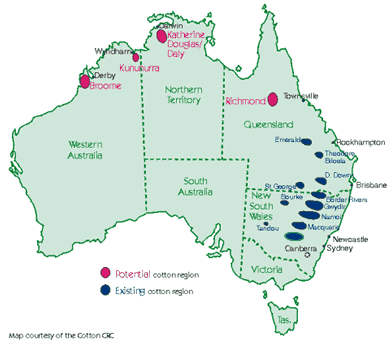|
November 3, 2003
From Cotton Communications
Premiminary
results from harvesting experimental Bollgard®II crops in the
Ord region of Western Australia indicate prospects for high
yields and minimal Heliothis sprays.
 Stephen
Yeates from CSIRO Plant
Industry in Darwin, who is northern research coordinator for
the Cotton
CRC, said recently picked cotton should yield about 8.3 bales
to the hectare at Kununurra, with good but more variable yields
also at Katherine. Stephen
Yeates from CSIRO Plant
Industry in Darwin, who is northern research coordinator for
the Cotton
CRC, said recently picked cotton should yield about 8.3 bales
to the hectare at Kununurra, with good but more variable yields
also at Katherine.
Speaking on the CSD weekly Web on Wednesday video, Mr Yeates
said “fantastic” was the only way to describe these results.
“Nothing has been sprayed for Lepidopterous or Heliothis this
year. Obviously we have had some species to spray, mainly mirids
and a little bit of aphid, but no problems with Heliothis thanks
to the Bollgard®II,” he said.
In a trial comparing unsprayed conventional cotton and
Bollgard®II crops, the former yielded a bale or less per
hectare, while the Bollgard® crop exceeded 8 bales/ha,
highlighting the benefits of Bollgard® in controlling insects.
He said fibre quality was currently being assessed, but early
indications suggested that early planting and a lack of cool
weather earlier in the season would be beneficial to fibre
quality.
“Most of the crops went in by the
middle of March, which was five weeks earlier than in previous
years. That’s why we are picking now. We have avoided all
harvest rain, and the warm early weather got the crop going
before the cool nights came in.
“We are also down the track a long way
with the new Sicot 35B, which has been selected for the north.
It has a high degree of tolerance to cool nights, and good fibre
length.”
He said several research projects were
still underway in the north at Katherine, Kununurra, and on
Shamrock Station just south of Broome.
New work in 2003 at Katherine involves
potassium and its effect on the disease alternaria, which is
important there, while at Kununurra research involves studies of
virgin soils, which are inherently low in phosphorous.
Experiments at Broome involve Bollgard® and Roundup Ready®
technology and their environmental impact.
Commercial cotton production was
abandoned on the Ord in the early 1970s due to uncontrollable
insect problems and unsustainable pest management practices.
The Cotton
CRC has
been involved in research in northern Australia since 1999. Its
aim there is to define if cotton and suitable rotation crops can
be grown without adversely impacting on land, the environment
and the ecology of the region, on competing land use systems,
and on regional community and recreational activities. |